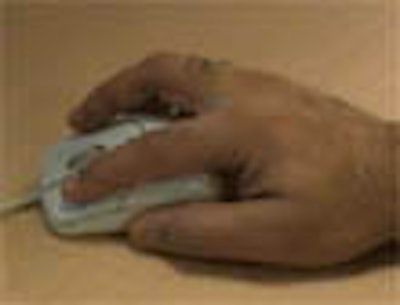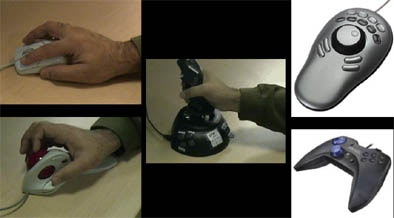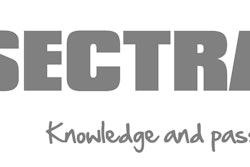
A lowly computer mouse aced the race for best input device in lung CT datasets. In a user study conducted at the University Hospital of Cleveland, the murine contender won out over an array of navigational devices, including a trackball, a video game joystick, a jog-dial, and a gamepad.
"With the increasing spatial and dynamic resolution of CT studies and a new generation of scanners, it will be even more challenging in the future to read all these studies," said Dr. Thorsten Fleiter in a presentation at the 2003 RSNA meeting. "An increasing number of study phases and multimodality studies will also be realized, and radiologists will have to review more and more images -- there's no doubt about it."
CAD will be part of the solution to the study overload, and good interface devices will be crucial in helping radiologists navigate studies quickly and efficiently, he said. Vendors are continually looking to improve their workstation designs.
The study aimed to assess the impact of five input devices in five CT lung datasets, each with an average of 4.8 small, hard-to-find solid nodules. Images were acquired on a 16-slice MX 8000 IDT CT scanner (Philips Medical Systems, Andover, MA).
 |
| Tracking devices: upper left, Microsoft mouse; lower left, trackball; middle, joystick; upper right, Contour Design ShuttlePro (jog-dial); lower right, Logitech gamepad. Images courtesy of Dr. Thorsten Fleiter. |
The trackball is commonly used for navigating radiology datasets, and, in fact, is the default device on the institution's Philips workstation, Fleiter said. The force-feedback joystick is of the type commonly used in video games, as is the Logitech gamepad, which requires both hands to operate. The Contour Design jog-dial is a rotational device commonly used in video editing, with datasets even larger than those used in radiology, Fleiter said.
"The (modified) workstation allowed real-time scoring," he said. "All of the buttons were disabled, so all you could do was go through the datasets (with the various input devices) and find the nodules. We reviewed the time needed to find the first nodule, the time needed to review the whole study, the number of detected nodules, then the comfort rating and the preference rating."
Prototype controls on each device provided a variable-speed cine mode, and enabled the radiologists to move forward and backward through the images (average n=250).
The reviews were completed in an average of 5.27 minutes (± 1.36 minutes) for all devices; the mouse (T=4.2 ± 0.913 minutes) was faster than the joystick (T=6.00 ± 1.29 minutes) (p<0.05). As for average time to locate the first nodule (30.5 ± 28.6 seconds), both the mouse (19.2 ± 18.7 seconds) and the trackball (16.1 ± 8.1 seconds) beat the joystick (T=55.7 ± 42.4 seconds) (p<0.05). The radiologists found an average of 5.5 nodules (± 2.4 nodules) per case.
Interestingly, the lowest preference scores (1-5) went to the trackball (2.1), compared with the jog-dial at 4.0, the gamepad at 3.7, the mouse at 3.5, and the joystick at 3.3 (p<0.05). The mouse was rated the most comfortable device overall (4.3), compared with the jog-dial at 4.0, the joystick 3.3, and the trackball again lowest at 2.3. The least fatiguing device was the jog-dial (1.3), followed by the gamepad (1.7), the joystick (1.9), the mouse (2.0). The trackball continued its losing streak as the most fatiguing device to use (3.3).
Review times were fastest with the mouse and slowest with the joystick, while the trackball had the lowest rating in all of the preference-score categories, Fleiter concluded.
"The mouse is the best compromise for simple scrolling purposes," he said. "The joystick and the gamepad are too slow and less precise, and nobody really likes the trackball, which is one of the main devices used in workstations.... The perfect input device has (yet) to be developed."
The group plans to continue its work with more challenging studies that include multi-organ reviews and additional device controls for slice thickness, rendering methods, and non-axial views, Fleiter said.
A member of the audience asked if the radiologists might have begun memorizing the five datasets before they repeated their review of each dataset with each input device. Fleiter responded that the nodules remained small and quite difficult to find throughout the study, and that the results of the randomly ordered reviews showed that radiologists' overall performance did not improve as they worked on the same datasets with different devices. Similarly, the radiologists' previous experience with the trackball did not appear to confer any advantage on it in the study, he said.
By Eric BarnesAuntMinnie.com staff writer
February 9, 2004
Related Reading
Sectra breast workstation receives 510(k), January 29, 2004
Mobile CT proves invaluable in SARS outbreak, January 22, 2004
Electronic exam ordering offers pros, cons in PACS, January 6, 2004
Consumer flat-panel displays show promise for CT diagnosis, June 8, 2003
Copyright © 2004 AuntMinnie.com



















